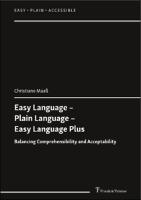Easy Language – Plain Language – Easy Language Plus
Balancing Comprehensibility and Acceptability
Abstract
This book shows how accessible communication, and especially easy-to-understand languages, should be designed in order to become instruments of inclusion. It examines two well-established easy-to-understand varieties: Easy Language and Plain Language, and shows that they have complementary profiles with respect to four central qualities: comprehensibility, perceptibility, acceptability and stigmatisation potential. The book introduces Easy and Plain Language and provides an outline of their linguistic, sociological and legal profiles: What is the current legal framework of Easy and Plain Language? What do the texts look like? Who are the users? Which other groups are involved in the production and use of Easy and Plain Language offers? Which qualities are a hazard to acceptability and, thus, enhance their stigmatisation potential? The book also proposes another easy-to-understand variety: Easy Language Plus. This variety balances the four qualities and is modelled in the present book.
Keywords
inclusion; communication; easy language; linguistics; terminologyDOI
10.26530/20.500.12657/42089ISBN
9783732906918, 9783732992997Publisher
Frank & TimmePublisher website
https://www.frank-timme.de/Publication date and place
Berlin, 2020Series
Easy – Plain – Accessible, 3Classification
Semantics, discourse analysis, stylistics
Grammar, syntax and morphology
Translation and interpretation
Communication studies
Educational strategies and policy


 Download
Download Web Shop
Web Shop